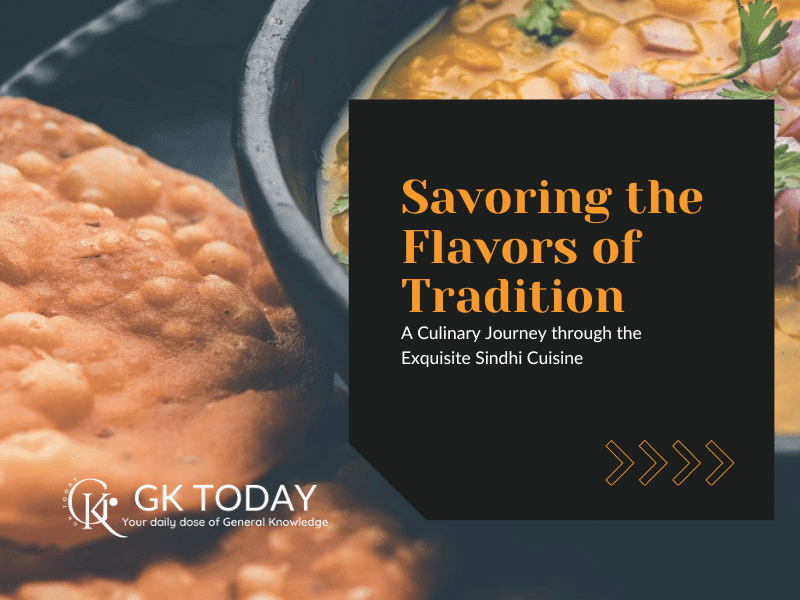Introduction:
The gastronomic landscape of the Indian subcontinent is a tapestry of diverse culinary traditions, each reflecting the rich cultural heritage of its respective region. Among these culinary treasures is the delectable Sindhi cuisine, a fusion of ancient flavors and influences from the Sindh region, which is now a part of Pakistan, and the various places where the Sindhi diaspora has settled, particularly in India.
Rooted in history and traditions, Sindhi cuisine offers a delightful blend of aromatic spices, robust flavors, and an array of textures that tantalize the taste buds. This article embarks on a culinary journey through the exquisite Sindhi cuisine, exploring its origins, traditional dishes, and the significance of food in Sindhi culture.
Part I: The Essence of Sindhi Cuisine – A Historical Perspective
- Geographical and Cultural Influences:
Sindh, a fertile region situated along the Indus River, has been a melting pot of cultures and influences throughout history. Its cuisine reflects the impact of trade with neighboring regions, such as Persia, Central Asia, and the Middle East, resulting in a unique fusion of flavors and ingredients. - Traditional Cooking Techniques:
Sindhi cuisine is known for its simplistic yet effective cooking techniques. Many dishes are slow-cooked in earthenware pots to enhance flavors and retain the nutritional value of the ingredients. The art of “bhunno,” sautéing spices to perfection, is a common practice in Sindhi kitchens. - Significance of Food in Sindhi Culture:
Food holds immense cultural and social importance in Sindhi traditions. Sharing a meal with family and friends is an essential part of social gatherings and festivals. Additionally, many dishes have religious significance and are prepared during specific occasions and ceremonies.
Part II: A Mélange of Flavors – Popular Sindhi Dishes
- Sai Bhaji:
Sai Bhaji, the quintessential Sindhi dish, is a delightful mix of greens, lentils, and vegetables. Spinach, dill, and mustard greens are cooked with chana dal (split chickpeas) and a medley of vegetables, creating a nutritious and flavorsome stew. - Sindhi Kadhi:
A tantalizing blend of chickpea flour (gram flour) and yogurt forms the base of Sindhi Kadhi. This tangy and spicy curry is replete with an assortment of vegetables and often accompanied by crispy pakoras (fried fritters). - Sindhi Biryani:
Sindhi Biryani, a favorite among food enthusiasts, showcases the amalgamation of traditional Sindhi flavors with aromatic rice and succulent meat, usually mutton or chicken. The dish is layered with fragrant spices, saffron-infused milk, and garnished with fried onions, mint, and coriander leaves. - Koki and Sindhi Puri:
Koki is a flatbread made with whole wheat flour, flavored with ghee (clarified butter), and spiced with cumin and ajwain seeds. Sindhi Puri, on the other hand, is a deep-fried, puffed bread that complements a variety of curries. - Sindhi Saibhaji:
A delightful dessert that holds cultural significance, Sindhi Saibhaji is made from roasted whole wheat flour, ghee, and jaggery, all cooked together to create a sweet and nutty confection.
Part III: Festive Delights – Sindhi Sweets and Snacks
- Singhar Ji Mithai:
Singhar Ji Mithai is a quintessential Sindhi sweet prepared during festive occasions. It is made from roasted gram flour, ghee, and sugar, resulting in a dense and rich fudge-like dessert adorned with sliced almonds and pistachios. - Dal Pakwan:
Dal Pakwan is a popular Sindhi breakfast delicacy. Chana dal is simmered with aromatic spices and served with crispy, deep-fried flatbreads (pakwan), creating a delightful combination of flavors and textures. - Aloo Tuk:
Aloo Tuk, crispy fried potatoes, is a simple yet addictive Sindhi snack. The potatoes are seasoned with a blend of spices, including chili powder and chaat masala, to add a burst of flavors. - Seyal Phulka:
Seyal Phulka is a traditional Sindhi breakfast dish that repurposes leftover phulkas (rotis). The phulkas are sautéed with onions, tomatoes, and spices, resulting in a savory and satisfying meal.
Part IV: The Culinary Legacy – Sindhi Street Food
- Sindhi Pani Puri:
Sindhi Pani Puri is a beloved street food delicacy, featuring hollow puris filled with a flavorful mix of spicy, tangy tamarind water, chickpeas, potatoes, and a blend of chutneys. - Koki with Chana Chaat:
Koki, the Sindhi flatbread, is often relished as a street food delicacy, served with spicy chana chaat—a zesty chickpea salad seasoned with spices and tangy chutneys.
Part V: Culinary Adaptations – Sindhi Fusion Cuisine
As the Sindhi community spread to different parts of India and beyond, their culinary traditions evolved and adapted to local tastes and ingredients. In metropolitan cities like Mumbai, where a significant Sindhi population resides, you can find innovative fusion dishes that blend traditional Sindhi flavors with contemporary cooking styles.
- Sindhi Sushi:
Sindhi Sushi is a creative adaptation that replaces the traditional raw fish with marinated vegetables or paneer (Indian cottage cheese). The sushi rolls are infused with Sindhi spices and served with tangy chutneys. - Sindhi Pizza:
Sindhi Pizza is a fusion dish that replaces the regular pizza base with koki, while retaining the traditional pizza toppings. The result is a unique combination of Italian and Sindhi flavors.
Conclusion:
Sindhi cuisine is a true testament to the cultural heritage and rich culinary legacy of the Sindhi community. It embodies the essence of tradition, history, and resilience, with each dish carrying a story of its own. From the earthy flavors of Sai Bhaji and Sindhi Kadhi to the festive delights of Singhar Ji Mithai and Dal Pakwan, Sindhi cuisine offers a feast for both the palate and the soul.
As the Sindhi diaspora continues to thrive in various parts of the world, their culinary traditions stand as a bridge that connects generations and preserves the flavors of the past while embracing the innovations of the future. So, let us embark on a delightful gastronomic journey and savor the exquisite flavors of Sindhi cuisine, celebrating the cultural richness and diversity it brings to our tables.




















+ There are no comments
Add yours